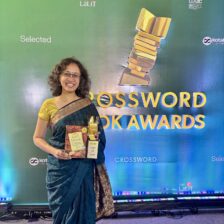I read article after article about how Indian literature for children is on the rise. I read about lit fests and how these promote Indian writers and Indian literature. I read about new publishers and new writers all over the country. I feel encouraged, thinking about my future (and present) as a writer.
Yet, against all that optimism, a few things come to mind.
- I often play a game with children, encouraging them to find out what the others read. Recently, I watched sixty children running around enthusiastically as they played the game, shouting to one another. When they shared what they loved and hated reading, not a single Indian writer or book was named.
- In a Writers’ Club that I conduct, children write about France and America and England and Australia, rarely India. I still meet Mary and Lucy, and even made-up names of various sorts, but rarely Indian names.
- When children tell Indian stories, the stories usually follow a traditional storytelling pattern of a fable, followed by a very clear moral.
There are other things I could add to this, but this post will carry on forever if I add everything. Let me just say this. When I ask children whether they read anything Indian, “Yes!” they reply, excitedly. “Sudha Murthy. Panchatantra. Akbar and Birbal. Tenali Raman.”
Fantasy stories, school stories, modern stories – these belong to a world separate from our Indian lives.
Why don’t we read Indian stories? I ask myself. And why don’t children want to write them? I talked to the children about this and we came up with a few things.
- Writing in English is restrictive, they say.
Write in another language, I suggest.
That’s restrictive too! No one speaks only one language all the time! How can we write in just one language? When people talk, they use several languages! But abroad … Yes, there it’s believable that they speak just one language at a time. - When I write a story set in India, say the children, how can I include different kinds of people like the driver and the maid and the gardener? It’s so lame when everyone speaks English. And so stupid if I have to have long passages in another language.
- Mrs Green and Mrs Brown are safe names. They don’t come with stereotypes that are part of TV-watching children’s “knowledge”. Mrs Iyer has to say ‘Aiyo’. Mr Nair has to have a thick Malayali accent and relatives in the Gulf. Old Mrs Thadani has to be rich and stingy.
Mrs Green? She can be a true product of pure imagination! Though, of course, she can’t be Indian. That’s taken for granted. - What about Bollywood? I ask. So much that is unimaginable happens there. Why try to make everything painstakingly real in writing? The children shrug, uncomfortable with the idea. Let the unreal be distant, they seem to say. Let it be far away from us and something we imagine …
And then I think again of Adichie’s talk on the danger of a single story, and realise how much we romanticise what we do not know.
How much more beautiful autumn and spring are than monsoon.
How much prettier Alice is than Tanvi.
And how fantasy, pure fantasy, has to have people with “posh” accents. Not Indians, of course. Harry, Peter and Lucy can have fantastic adventures in magical places. How can a magical, mystical place have a Tarun Reddy, for example?

Leave a Reply